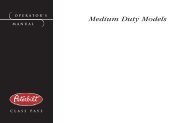MODEL 330 OPERATOR'S MANUAL - Peterbilt Motors Company
MODEL 330 OPERATOR'S MANUAL - Peterbilt Motors Company
MODEL 330 OPERATOR'S MANUAL - Peterbilt Motors Company
You also want an ePaper? Increase the reach of your titles
YUMPU automatically turns print PDFs into web optimized ePapers that Google loves.
Using the Brake System<br />
• After the engine is started, warmed up, and you are<br />
ready to get under way, turn the exhaust brake switch<br />
ON for added braking effect.<br />
WARNING! Do not use the engine retarder when<br />
operating on road surfaces with poor traction<br />
(such as wet, icy, or snow covered roads or<br />
gravel). Retarders can cause the wheels to skid<br />
on a slippery surface. You could lose control of<br />
the vehicle and/or jackknife if the wheels begin<br />
to skid, resulting in an accident.<br />
However, if your vehicle is equipped with Rockwell/WABCO<br />
anti-lock brakes (ABS), the operation of the exhaust brake (if<br />
turned ON) will be controlled by the ABS. For more ABS<br />
information, see “Anti-Lock Braking System” on page 79.<br />
For further details on how to use the exhaust brake, see the<br />
exhaust brake manufacturer’s Owner’s Manual.<br />
Brake Components<br />
The following is a brief description of the air/brake system. It<br />
is intended to supply you with general information on how the<br />
system works. For complete information see the Medium<br />
Duty Maintenance Manual.<br />
Operating Instructions<br />
Compressor: supplies air to the system. System pressure is<br />
controlled by the governor.<br />
Governor: controls the air pressure in the system by actuating<br />
the compressor discharge mechanism. Its cut-out pressure<br />
is 115 to 125 psi (793 to 862 kPa). Its preset cut-in<br />
pressure is set to between 13 to 25 psi (90 to 172 kPa) below<br />
the cut-out pressure setting (cut-out and cut-in interval is not<br />
adjustable).<br />
Safety Valve: installed on the supply reservoir outlet. It<br />
should “vent off” at 150 psi (1034 kPa) permitting air to<br />
escape.<br />
Air Dryer (Option): collects and removes moisture and contaminants<br />
from the air as it travels from the compressor to the<br />
wet tank (reservoir).<br />
Compressed Air Tanks: The wet (supply) and dry (service)<br />
tanks are located behind the battery box and on the frame<br />
rail; the supply tank is below the front service tank. See “Air<br />
Tanks” on page 165.<br />
– 84 – PB1318 3/01 Model <strong>330</strong>
















